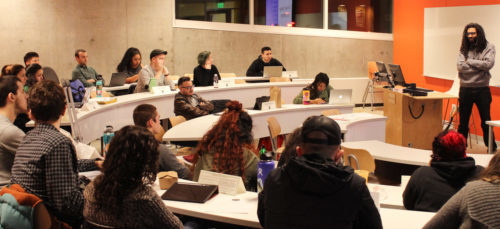Political climate questioned by panel
The Oregon Peace Institute sponsored a workshop called “The Art and Consequences of Making Enemies” at the First United Methodist Church on Tuesday night.
������� The purpose of the workshop was to discuss influences in American society that contribute to “a climate of ready hatred,” using media literacy as a tool “to understand the subtle indoctrination into enmification that we receive from childhood forward.”
Amanda Byron, chair of the board of The Peace Institute and adjunct faculty member of the graduate program in conflict resolution at Portland State University, headed the workshop.
Byron said she has had an increasing interest in the topic, facilitated by the changing political climate in the past 15 months, and feels a sense of urgency about broadening the public’s awareness at this time.
The discussion focused on the role of the media in forming people’s ideas about themselves, others and society. Byron looks at the media as modern storytellers who set the standards for values, behavior and social norms.
She believes, media literacy can counteract some of the detrimental effects of these stories.
Media literacy is a term applied to the expansion of awareness and the assessment of the impact of the media on people, communities, society and the planet.
Byron claims television sets children up to be receptive to corporate media propaganda as adults. She said the formulaic plot line in most children’s cartoons and programs lead kids to believe there is a clear distinction between good and evil. In these instances, the antagonist is evil because he or she does bad things, and the protagonist is good because he or she does good things.
Furthermore, Byron said cartoon villains reflect the political enemies of the U.S. at a given time.
In the 1970s, the villains had Russian accents, Middle Eastern accents in the 1990s and German accents during and just after the world wars. Byron said often these villains have some characteristic that portrays them as being “less than human,” such as a disability, a speech impediment or dark skin.
Byron implied the good/evil dichotomy leaves no room for the possibility that good people do bad things. She said the media sells black and white stories, enticing viewers into oversimplification by making them eager to make simple distinctions between right and wrong.
Many participants seemed to feel television impairs critical thinking skills and prevents people from making true connections with each other. Instead, they said viewers bond to the characters in their favorite shows and to other viewers by talking about those shows.
Rick Seifert, board treasurer of the Northwest Media Literacy Center and founder of and writer for the Southwest Community Connection newspaper, sees television as a negative influence on intellectual life.
“This medium does not lend itself to rational discourse or reflection,” Seifert said. “The images are hard to process rationally.”
The role of the U.S. justice system was also discussed in relation to the dichotomy of good and evil. Byron claimed that locking up people who have done bad things perpetuates hatred and enemy making by treating them as bad people who are not fit to move around and participate in society.
The group threw out ideas about how the media affects people when they get older. They touched on the detrimental effect TV and magazines have on women by showing them impossible images they feel they should live up to, and the effect that certain language and images in news can have on the public.
Byron pointed to the propaganda surrounding the proposed war on Iraq as an example of the latter. She said that media perpetuates an idea that people should hate Middle Easterners because they pose a threat to the American way of life.
Many participants found it easy to understand why that idea has found a comfortable home in America’s psyche. They agreed that it is natural to feel fear when one feels threatened. Many times, that fear can turn to hate and be manifested as violence.
David Reid, outreach coordinator of the Johnson Creek Watershed Council, thinks the American public should put the blame elsewhere.
“I think that the greatest threat to our way of life is the way we’re living it,” Reid said.
Byron suggested people need to acknowledge patterns of enemy making and make deliberate choices to not hate. She stressed the potential individuals have to change political decisions and climates.
“Nations are incapable of hating,” she said. “Only individuals are capable of hatred.”
A few members of the group suggested hate can be assuaged by trying to understand one’s self and other people. The recognition and acceptance of one’s own insecurities, as well as a struggle against the “fight-or-flight” response innate in human beings, appealed to participants as tools against hatred.
Dr. Susan Fuhr, psychotherapist and part-time instructor of psychology at Portland State, said that a lot of people struggle with their “emotional legacy.” She said it’s unreasonable to ask ourselves, as human beings, to suddenly reach enlightenment and never hate again.
“I can’t not fear,” she said, but added that one can be aware of and question feeling threatened, and make a conscious decision to not act to the detriment of others.
Information on the Oregon Peace Institute and their upcoming events can be found on the Web site at www.orpeace.org.
For more information about media literacy, visit the Northwest Media Literacy Center Web site at www.mediathink.org.




